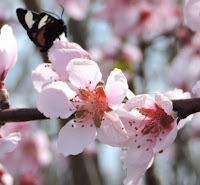 |
| Crabapple in full bloom - REK |
 |
| Grapevine Epimenis nectaring - REK |

We were now joined by our botanist friend Matt and Dave. Now the leaf buds scales were off, revealing the small narrow leaves. I thought they most resembled Narrow-leafed Crabapple, Malus augustifolia, but our Missouri trees books said that species only occurs in the Bootheel of Missouri and their leaves are said to be red when first emerging, contrary to our tree.
 |
| Smooth bark, horizontal lenticels |
The bark of the tree was smooth with horizontal lenticels. That and the flowers with five petals Matt explained were the identifying features of the Malus genus of the Rosaceae family. These blossoms were pink and had from 10-20 stamens with yellow anthers just as the book says.
From there on we were left guessing about the species. The Prairie Crabapple Malus ioensis is the most common native crabapple in our region but not a perfect fit. The possibility remains that it could also be an exotic escapee.

The leaves didn't help us much, not fitting any one species. Time for an expert opinion so I sent it off to Justin Thomas. His response:
"Gorgeous tree! I was able to see that the outside of the sepals are hairy, in one of your photos. That puts it with Malus ioensis. There are scattered records of aberrant hybrids of Malus ioensis with domestic apples, but that is unlikely."Malus ioensis - the Prairie Crabapple has a huge list of faunal associations, including moth caterpillars, web worms, etc. A wide variety of mammals consume the crab apple fruit, distributing its seeds widely.
As always (almost), Barb was right again on the species. How about them apples!
